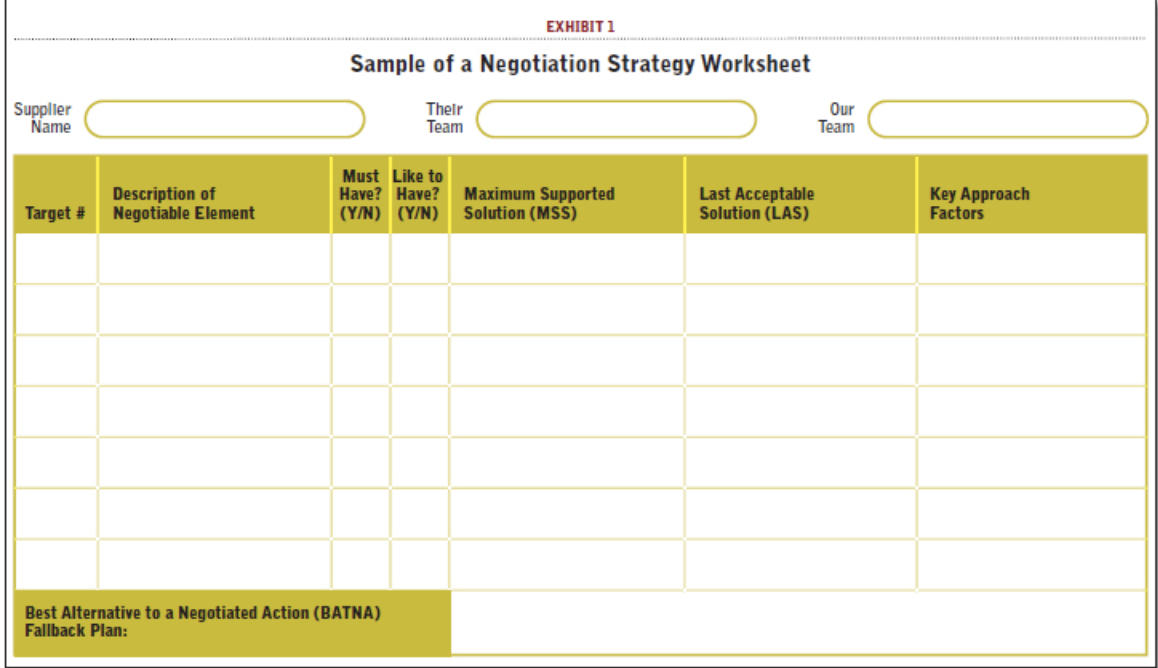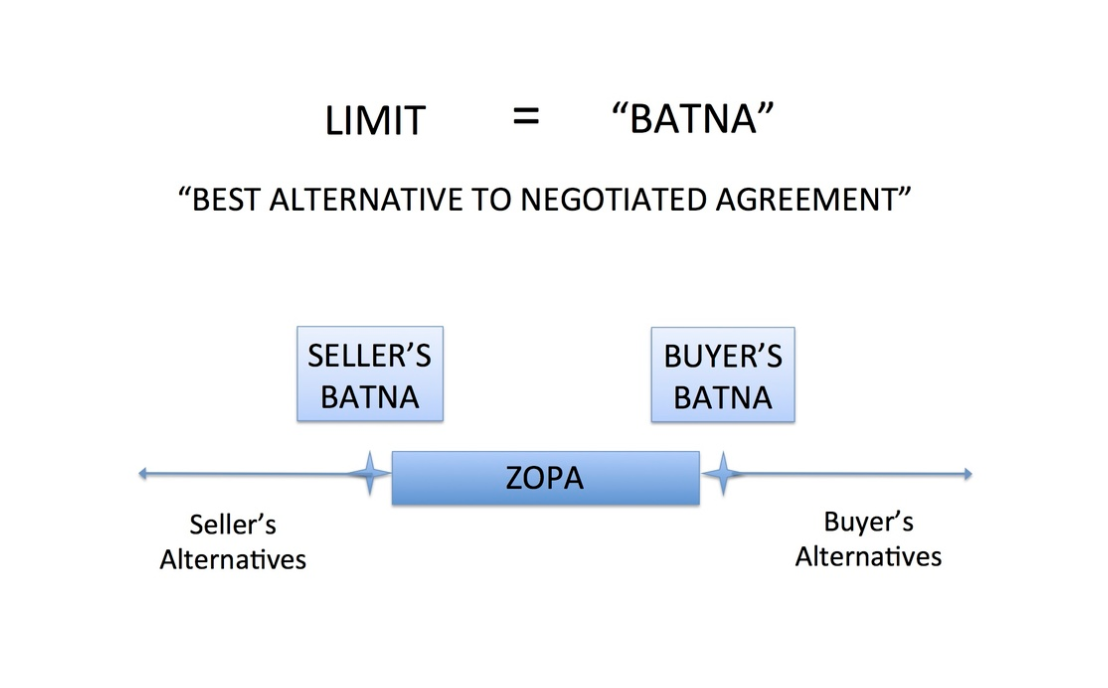As a buyer, you know that supplier negotiations are an opportunity to create value for your company. Simple Contract negotiation skills is a bare neccesity.
Companies that focus on price alone stand to lose out. Instead, buyers need to turn toward data-driven insights to improve spend, mitigate risks, and approach potential vendors with a strategic mindset.
We’ve compiled five of our favorite tips for negotiating better terms with suppliers.
[content_upgrade cu_id=”4303″]It pays to be prepared–subscribe here for your list of tips for preparing for the bargaining table[content_upgrade_button]Click Here[/content_upgrade_button][/content_upgrade]
1. What’s Your Best Alternative to a Negotiated Agreement (BATNA)?
Before you hit the negotiation table, you need to prepare all possible outcomes. One of those outcomes may be finding a supplier you like just as much as the one you’re speaking to now.
List out the terms to negotiate, such as cost, delivery schedule, and payment terms.
Start by gathering all of the information to make your case for the terms you want, but also have a handful of alternative paths that would achieve your desired outcome.
Try compiling this information in a worksheet like this one below. It’s a good visualization of each negotiable element that breaks down the “must haves” and “the nice to haves,” and can remind you when negotiations are veering outside of that “zone of possible agreement” (ZOPA).
From there, identify possible BATNAs by listing all of the things you can do if you don’t reach an agreement. What’s the best way you can complete your goal—without this particular supplier?
Basically, you need a few backup plans. If this one supplier doesn’t agree to your terms or present an attractive alternative—who else can you buy from? What terms can you counter with? When is it time to walk away?
2. Go Right to the Top
A lower-level salesperson won’t have the same authority as the boss and will err on the side of doing what they believe is best for the company—not yours.
We recommend working with the owner of the company, as the higher up the food chain, the more that the supplier will be able to do for you. Do your homework ahead of the meeting; identify the head honcho and get in touch. This person has the authority to make more strategic decisions than their frontline employees.
Beyond identifying the boss, you should also do a little digging.
Find out how long this company has been in business and how much business they do. What would this deal do for them?
As we’ve mentioned in our previous article on the Purchasing Chessboard, you’ll want to learn as much about the suppliers in the game as possible—especially who holds the cards. When suppliers are in a power position, buyers need to find ways to keep costs down.
Heading back over to AT Kearney, you’ll see this example of combining “chess moves,” based on potential risks and suppliers’ power. In the chart below, they’ve presented two potential buying strategies, but the buyer’s path hinges on what the seller says.
If you’re dealing with employees that lack the bargaining power to play the chess game or the experience to leverage their power—you miss an opportunity to negotiate the best terms possible.
3. Don’t Be Shy — Ask for Exactly What You Want
Be outrageous in your early demands and ask for what you want. The worst that can happen — the supplier says no. Then you start working on the compromise.
The whole concept of negotiation is understanding that there will be some kind of compromise, so set the bar high to increase your chances of compromising on still-favorable terms. There’s also this conventional wisdom that the first five minutes of the negotiation set the tone for the final result.
A Harvard study found that throwing out the first number increases the odds that the negotiation will tip toward your favor.
Procurement leaders need to enter negotiations with a clear understanding of what terms would best help them achieve their business goals. Those teams that fail to prepare leave themselves vulnerable to quick counters, upsets, and loss of control.
Again, as we mentioned, alternatives are essential–but you don’t want to start the conversation on a compromise. All proposed terms must make sense based on market trends, company capacity, and what the competition charges.
[bctt tweet=”Want to get sweeter terms? Highlight what’s in it for your suppliers by offering X, Y, and Z in exchange for A, B, and C.” username=””]
What happens if they shut you down? Keep the conversation moving, and ask for a counter.
4. Ask for a Counter Offer
If you are an important client to this supplier, they won’t want to lose your business, so if your initial proposal is too much—ask, “if that’s not reasonable, what is?”
Don’t respond with “why” or keep lowering your numbers. This is the time to listen and prepare to make your next move. For your aggressive offer to retain the most bargaining power, you need to stand firm on those “need to haves.”
Your goal is to gather as much intel as possible while revealing minimal details about your business objectives. Rather than scale back your initial proposal, ask the supplier to share what terms would work for them. This works because, rather than soften your position, you’re getting the vendor to “extract” compromises. When you do reach an agreement, the seller will feel satisfied after negotiating a few concessions.
If the supplier counters with a price increase or unfavorable terms, resist. You’re allowed to say no and let them know what works better for you. Think back to the BATNA criteria you outlined earlier–and let the supplier know that x counter won’t work.
Again walking away is always an option, just be sure that you really do have other offers on the table.
5. Back it Up with the Power of Silence
After you’ve laid out your proposed terms and compromises, sit back and let the vendor talk. You know this is a classic negotiation tactic, once you’ve made your offer, do not volunteer any additional information until the other party responds.
Many stakeholders aren’t experienced negotiators, so they may be prone to oversharing about budgets, deadlines, or damaging pieces of information.
Before you and your team start the negotiation process, make sure everyone is on the same page about how much information you plan on divulging to suppliers.
Transparency matters when it comes to being honest about financials and terms laid out—after you sign the contract. But, during the negotiation phase, you’ll want to be more measured when it comes to sharing with vendors.
Wrapping Up
These are just a few of the negotiation tactics that procurement teams can use.
As a buyer, be prepared to counter suppliers by planning ahead and reinforcing mutual benefits. Remember that once the ink on that final deal dries, your work is far from done.
Your job now is to build and nurture a sustainable relationship with suppliers and make sure that you—and the vendor—remain in compliance with these hard-won terms.
Click here for more about how ProcurementExpress.com helps teams focus on supplier relations.
[content_upgrade cu_id=”4303″]Get Ready for the Big Day: Download Your Supplier Negotiation Preparedness Checklist Here[content_upgrade_button]Click Here[/content_upgrade_button][/content_upgrade]






